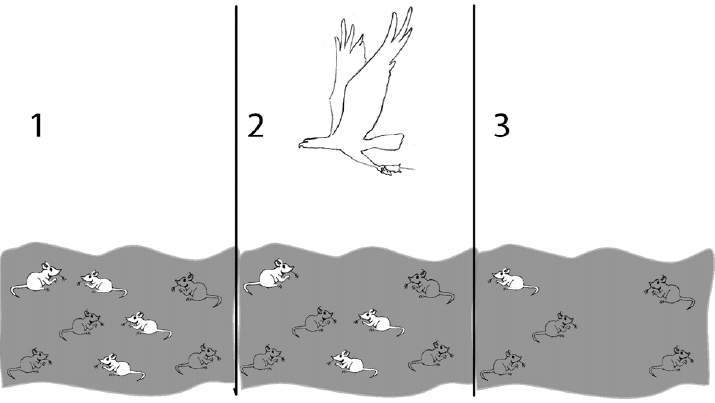Procedure:
Day One
-
Brainstorm with students key terms:
evolution, adapt, survival of fittest, reproduction, genes, traits, environment, selection, competition, predator, prey
- Distribute index cards and instruct the students to write the definition of the term, draw an illustration or symbolic representation of the term and write a sentence using the term.
- Have students post one of their index cards on the classroom word wall.
Day Two
-
Show the
provided illustration on an overhead
projector or smartboard.
-
Have
students observe and describe what is happening in figures 1-3. Record their
answers on the chalk board or smartboard.
-
Distribute
worksheet 1 to the students and go over questions. See
worksheet 1.
-
Have
students that are done with the assignment log into
http://www.sciencenetlinks.com/Esheet.cfm?DocID=80
to either watch the movie
(subscription required) or play an interactive activity on natural
selection. (Nowhere
to Hide)
-
Students
should answer the questions of Nowhere to Hide for homework. Student
worksheet is found on
www.sciencenetlinks.com/pdfs/nowhere_actsheet.pdf
Day Three Simulation of Natural Selection
In this
activity students act as predators of jelly beans which represent any species to
simulate evolution by natural selection.
Students are told that smaller jelly beans are easy to catch and taste better
while bigger jelly beans are faster but taste bitter.
-
Divide
students into groups of four. One person from each group will get the
materials.
-
Each
student will create a lab report as they perform the activity.
-
Students
will poke five holes to bottom of brown paper bags and place a cup of
various jelly beans inside the bag.
-
Have
students shake the bag and count the jelly beans that fall through the
holes. These are considered dead prey. Population of jelly beans that remain
inside the bag will be consider “survivors” and the first generation of
parents.
-
Record
first generation results on their lab report..
-
Have
students get a new cup of jelly beans (this represents the offspring of
survivors) and place inside brown bag. Shake
again. This process is repeated four more times and students observe the
population frequency.
Reading Strategy:
-
Have
students read article about wooly mammoth on
http://www.nature.ca/notebooks/english/woolly.htm
-
Have
students complete the worksheet
about wooly mammoth. Log onto
http://www.sciencenetlinks.com/pdfs/mammoth2_actsheet.pdf
Illustration

New York State Science Standards:
Standard 1. Performance indicator 2.3, 3.1
Standard 4. Performance indicator 3.1a-3.1i, 4.1a, 6